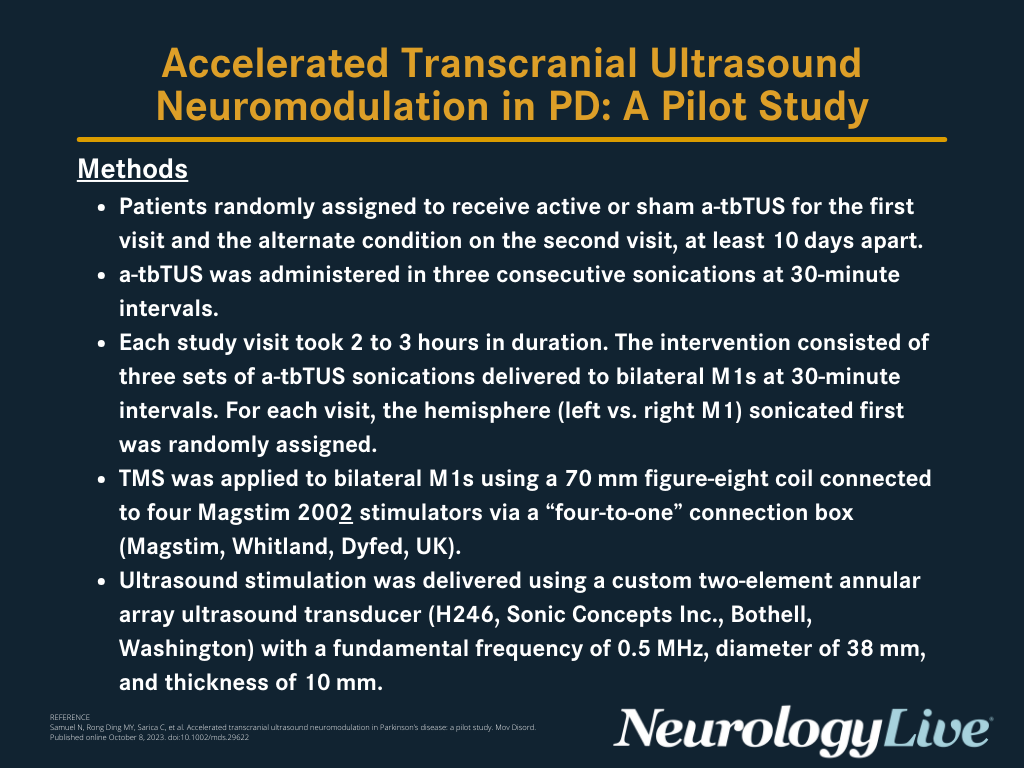News
Article
Motor Evoked Potentials of Parkinson Disease Increased Through Accelerated Transcranial Ultrasound Neuromodulation, Pilot Study Shows
Author(s):
In a small-scale trial, patients with Parkinson disease on accelerated theta-burst transcranial ultrasound demonstrated higher motor evoked potentials than those on sham, with no statistically significant changes in MDS-UPDRS-III scores.
Andres Lozano, MD, PhD, FRCSC, FRSC

A recently published pilot study of patients with Parkinson disease (PD) showed that stimulating the bilateral primary motor cortices (M1) with accelerated theta-burst transcranial ultrasound (a-tbTUS) is feasible, with documented increases in motor cortex excitability. Increases in M1 excitability may suggest that changes in cortical circuits occur with a-tbTUS sonications, although treatment did not correlate with clinical motor outcomes.1
The study featured 10 patients aged 18 to 80 years with a PD diagnosis of at least 1 year and were on stable dopaminergic medication dose for a minimum of 4 weeks. Patients were evaluated in the OFF-medication condition, with all PD-related medications withdrawn for at least 12 hours before the start of each study visit. Each individual underwent 2 visits of either sham or active a-tbTUS, randomly assigned and separated by at least 10 days.
Senior investigator Andres Lozano, MD, PhD, FRCSC, FRSC, chairman of the division of neurosurgery at the University of Toronto, and colleagues primarily assessed feasibility and safety of the neuromodulation approach using occurrence of adverse events (AEs). In addition, the investigators used transcranial magnetic stimulation (TMS)-elicited motor evoked potentials (MEPs) to assess motor cortical excitability before and clinical outcomes through the Movement Disorder Society Unified Parkinson’s Disease Rating Scale (MDS-UPDRS)-III.
TMS pulses were delivered at an inter-trial interval of 5s and used the stimulator intensity inducing MEPs of ~1 mV peak-to-peak amplitude (SI1mV) at baseline (mean, 59.2% [±10.6%] maximum stimulator output [MSO]). Fifteen MEPs were recorded at each time point, with short-interval intracortical inhibition (SICI) and short-interval intracortical facilitation (SICF) probed using paired pulse TMS at M1. Ultrasound stimulation was delivered using a custom 2-element annular array ultrasound transducer (H246, Sonic Concepts) with a fundamental frequency of 0.5 MHz, diameter of 38 mm, and thickness of 10 mm.

After active sonication, MEP amplitudes significantly increased from 1.08 (±0.22) mV to 1.72 (±0.67) mV (t[9] = –3.61; P <.01), whereas those on sham saw no significant change (1.12 [±0.20] mV to 0.99 [±0.17] mV (t[9] = 1.91; P = .089). MEP ratio was also significantly different between active (1.58 [±0.5] folds) and sham (0.90 [±0.20] folds) conditions (t[9] = 3.54; P <.01) collectively supporting cortical facilitation by active a-tbTUS. Baseline measures of MEP amplitude [t(9) = 0.55, P = 0.59], SICI [t(9) = 1.60, P = 0.14], and SICF [t(9) = 2.09, P = 0.06] between conditions were not statistically different.
READ MORE: First-In-Human Trial of Nurr1 Activator HL192 in Parkinson Disease Initiated
"Although the small sample size of this study may have limited the ability to draw definitive conclusions regarding clinical outcomes, the results provide valuable information to inform power analyses for future studies,” the study authors wrote.1 "Focusing on patients with moderate to severe symptoms rather than patients with mild symptoms may increase the likelihood of detecting a significant effect. Overall, our findings offer valuable insight that can guide the design of future research in this area."
After the atbTUS procedure, there were no statistically significant between-group differences in MDS-UPDRS-III scores (active: t[9] = 1.8; P = .1; sham: t[9] = 1.6; P = .1); however, Lozano et al noted that the study was insufficiently powered to detect small effect sizes. In addition, in the active treated group, there was a nonsignificant trend toward improvement in the upper extremity (UE) rigidity scores (t[9] = 2.1; P = .06) compared with the sham (t[9] = 0.7; P = .5). Notably, all 3 patients with a baseline total UE rigidity score of less than 2 did not experience any changes in their scores in active condition, whereas 5 of the 7 patients with baseline score greater than 3 had at least 1-point improvement. There was no noted correlation between change in MEP amplitude and change in MDS-UPDRS-III scores.
There were limitations to the study, including the extended duration of the study visits, which may have contributed to patient fatigue and in turn potentially impacted the MDS-UPDRS-III scores. Patient fatigue and discomfort in the OFF-medication condition also constrained the ability to test multiple outcome measures. Additionally, while the study did not evaluate the neuropsychiatric effect of a-tbTUS, it did exclude those with prominent mood symptoms.
"Because we did not include a healthy control group in the study, we cannot determine whether the physiological responses to a-tbTUS in PD-OFF patients were normal," the study authors noted.1 "This would be an important direction for future studies. However, this was not the aim of the present study, which was to establish the feasibility and safety of a-tbTUS in PD patients to provide foundational knowledge for future phase II and III trials."
REFERENCE
1. Samuel N, Rong Ding MY, Sarica C, et al. Accelerated transcranial ultrasound neuromodulation in Parkinson’s disease: a pilot study. Mov Disord. Published online October 8, 2023. doi:10.1002/mds.29622
Newsletter
Keep your finger on the pulse of neurology—subscribe to NeurologyLive for expert interviews, new data, and breakthrough treatment updates.





